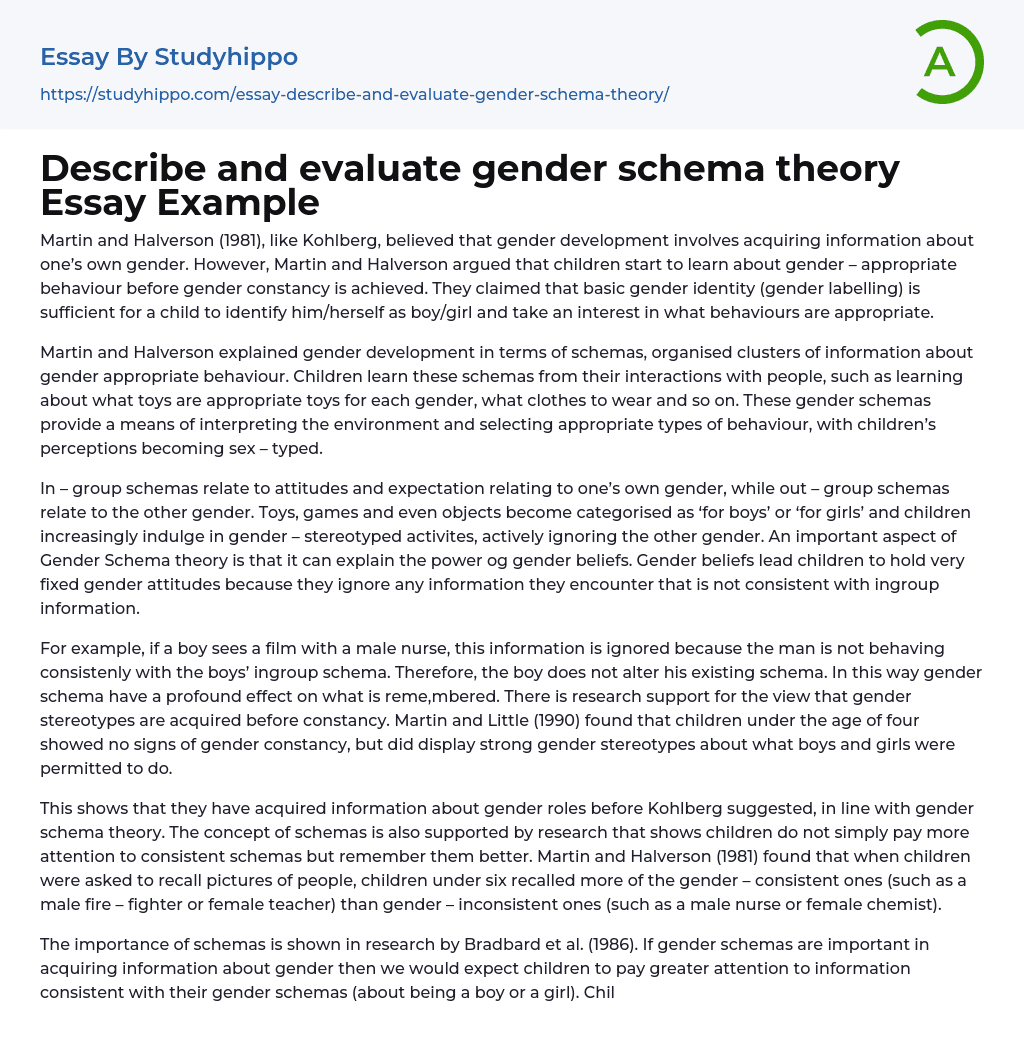According to Martin and Halverson (1981), the process of gender development involves acquiring knowledge about one's own gender. They agreed with Kohlberg that children start learning about proper gender behavior before achieving gender constancy. The authors stated that having a grasp of basic gender identity (identifying as either a boy or girl) is sufficient for children to recognize themselves and develop an interest in appropriate behaviors.
In terms of gender development, Martin and Halverson described schemas as organized clusters of information about appropriate behavior for each gender. Children acquire these schemas through interactions with others, such as learning which toys and clothing are suitable for their gender. These gender schemas help children interpret their surroundings and choose appropriate behaviors, ultimately influencing their perception of gender roles.
Acco
...rding to the Gender Schema theory, individuals have attitudes and expectations about their own gender (in-group schemas) and the opposite gender (out-group schemas). The theory suggests that toys, games, and objects are often labeled as 'for boys' or 'for girls', causing children to participate in activities based on gender stereotypes while disregarding the other gender. An important aspect of this theory is its explanation of how gender beliefs affect children's development of inflexible attitudes towards gender by disregarding information that conflicts with their understanding of their own group.
The impact of gender stereotypes on memory becomes apparent when individuals perceive information. For instance, if a boy watches a movie featuring a male nurse, he may disregard this fact due to his preconceived notions of typical male behavior within his social group. Consequently, this encounter does not result in any alterations in the boy's existing
schema. This illustrates the significant influence of gender schema on memory.
In 1990, Martin and Little conducted research that supports the notion that gender stereotypes are formed prior to children developing gender constancy. Their study revealed that children under four years old lacked an understanding of gender constancy but already possessed distinct gender stereotypes regarding acceptable activities for boys and girls.
Prior to Kohlberg's proposal, it can be inferred that individuals had already acquired knowledge about gender roles, which supports the gender schema theory. The concept of schemas is further supported by research indicating that children not only pay more attention to consistent schemas but also have better memory retention of them. In a study conducted by Martin and Halverson (1981), young children were asked to remember pictures of people. It was discovered that children under the age of six demonstrated higher recall abilities for gender-consistent images (such as a male fire-fighter or female teacher) compared to gender-inconsistent ones (like a male nurse or female chemist).
Bardbard et al. (1986) conducted a study to demonstrate the significance of schemas. They hypothesized that if gender schemas play a crucial role in acquiring gender-related information, children would display more attention towards information that aligns with their gender schemas, which are related to being either a boy or a girl. The study involved presenting gender neutral items, such as a burglar alarm or a pizza cutter, labeled as boy or girl items to children aged four to nine. Results indicated that participants exhibited greater interest in toys labeled according to their ingroup, meaning that boys were particularly interested in toys labeled as boy toys.
The cognitive developmental approach
has limitations as our thoughts may not align with our actions. Durkin's (1995) observation exemplified this, showing that couples who express a willingness to share domestic tasks often fail to do so. In other words, their intentions and thoughts do not match their behavior. Furthermore, cognitive developmental theory differs from other explanations of gender development.
The biological approach asserts that genes and hormones have the most significant influence on gender identity. Hormones affect brain development, leading to a masculinized or feminized brain, which can result in gender role behaviors. This perspective suggests that learning about gender schemas is not the only way to acquire gender roles. Another biological viewpoint, called the evolutionary view, argues that gender role behaviors are adaptive. In contrast, the cognitive developmental view proposes that individuals learn appropriate behaviors by observing others of the same gender.
- Social Construction of Gender essays
- Boy essays
- Gay essays
- Gender essays
- Gender Identity essays
- Gender Roles In Society essays
- Gender Stereotypes essays
- Girl essays
- Homosexuality essays
- Human Sexual Behavior essays
- Lgbt essays
- Man essays
- Masculinity essays
- Sexual Orientation essays
- Transgender essays
- Woman essays
- Anthropology essays
- Audience essays
- Charity essays
- Cultural Competence essays
- Emile Durkheim essays
- Gender Roles essays
- Generation essays
- Globalization essays
- Interpersonal Relationship essays
- People essays
- Race essays
- Social Change essays
- Social Class essays
- Social Movement essays
- Social Science essays
- Social Status essays
- Social Stratification essays
- Society essays
- Sociological Imagination essays
- Sociological Perspective essays
- Sociological Theories essays
- Stereotypes essays
- Web Dubois essays
- Experiment essays
- Explorer essays
- Hypothesis essays
- Observation essays
- Qualitative Research essays
- Research Methods essays
- Theory essays




